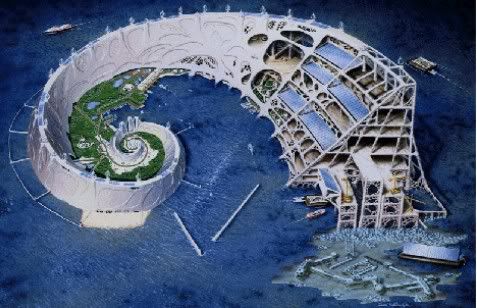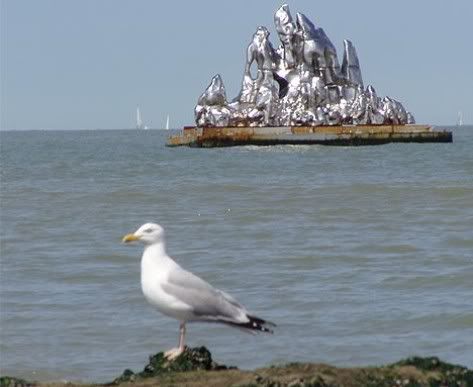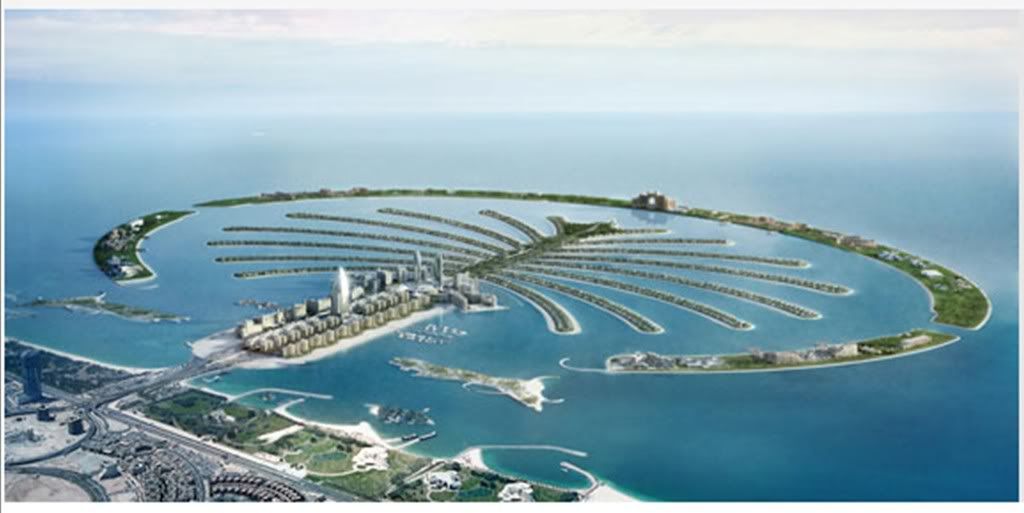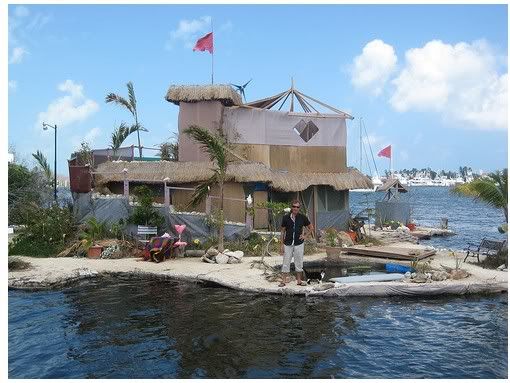The obvious solution is to boat them around and/or create floating constructs, but it's been done. I don't want underwater colonies because it doesn't serve the story idea. Then I toyed with the thought of deep drilling to tap the planet's asthenosphere to generate controlled underwater volcanic activity (which is what created a bunch of landforms on our planet) but that comes with a lot of logistical headaches and reminds me too much of what's happening now in the Gulf.
I'll keep working on it, but in the meantime, I thought I'd share some of the cool stuff I've come across while researching the concept:

German architect Wolf Hilbertz's Autopia Ampere, which builds itself using minerals from the sea via electrodeposition. I love this idea so much I am permanently green with envy.

Art becomes island: Chinese sculptor Zhan Wang's Floating Mountain of Immortals. This appeals to me on a couple of levels, and connects with something I've done a couple times in other books, but can you actually live in art?

Shimizu Corporation's environmental island cities: Green Float*. A beautiful idea that I don't see surviving our climate shifts, but still, hugely appealing and very well thought out.

Palm Jumeirah, one of Dubai's Palm Trilogy of manmade islands. Like a floating DisneyWorld for the yachting crowd, I guess.

Richard Sowa built Spiral Island on a base of thousands of plastic bottles (recycling at its finest) and while it was later destroyed by a hurricane, he's going to do it again with Spiral Island II.
Finally, I can never talk about cities or water worlds without mentioning Project Indigo, the mind-blowing vertical seaside metropolis imagined by artist Jesse van Dijk (for which I will be eternally grateful to Eva Gale for passing along to me.)
*Link swiped from Gerard over at The Presurfer.

Green Float is mind-boggling. Of course, my brain immediately conjured a story where the city is built by a corporation and workers find they can move in, but can't leave their "paradise" prison...
ReplyDeleteI came across a project like that when I was researching about solutions for Climate refugees for school.
ReplyDeleteLilypad is very impressive:
http://www.vincent.callebaut.org/page1-img-lilypad.html
I love Spiral Island. I'm thinking you may have given me an idea for all those discarded bottles I keep finding in the park.
ReplyDeleteFascinating ideas! Thanks for the links!
ReplyDeleteHow about a little ancient inspiration for turning water into land (and the problems that follow):
ReplyDeleteThe Aztecs built Tenotchitlan (aka Mexico city) on a lake by creating rafts and piling dirt on them. They were floating farm plots that became linked and organized and eventually bigger stuff got built on top. By the time Cortes discovered it, it was likened to Venice, with its maze of canals. This man-made land on top of a lake made the foundations of Mexico city very swampy, which is bad for bigger buildings.
When I visited as an exchange student in '93, we saw the outside of the original cathedral of Maria of Guadalupe, which had a tilt reminiscent of Pisa, and which no one was allowed to enter because of safety problems. I think Mexico City has been subject to sink holes too.
Mmm...some really interesting ideas there. One of my fantasy settings have a mysterious, watery city.
ReplyDeleteProject Indigo boggles the mind. I wonder how they keep themselves fed. And the water down there must be horribly polluted...
Bahrain has artificial islands too. (It's near Dubai.) I've visited them. They don't float--they're reclaimed land actually. The Gulf's so shallow that you can just dump a bunch of dirt and rocks into the water and create land for yourself. I lived on some--I would have never known if I hadn't been told and saw them making more. That being said, the islands like Palm Jumeirah are really fancy. They're cities themselves--their own shopping, mosques, schools, medical facilities, sports and recreation, as well as luxury houses and apartments. It's definitely meant for rich people. The islands are narrow, partly to look cool (a giant palm does look cool) but also so people can park their boats in front of their house.
ReplyDeleteI think Green Float is very interesting. I expect that someday people will colonize the oceans, either above or under them. The technology exists for either. There are even underwater hotels now. Thanks for sharing these. They're definitely interesting.
I wish I could somehow give you the magical idea you need (although I'm sure you'll come up with one eventually--probably soon!), but these are some of the coolest concepts I have ever seen. I'm loving Autopia Ampere (would it eventually look like a shell? How interesting, to have a man-made city on top of the ocean eventually look like something that actually came from the ocean) and Project Indigo.
ReplyDeleteWow, these are awesome!! The Autopia Ampmere and Palm Jumeirah are particularly engrossing.
ReplyDelete~TRA
http://xtheredangelx.blogspot.com
Thank you for the link to the Jesse Van Dijk site. That stuff is fantastically inspirational. I often look at sites like renderosity for ideas.
ReplyDeleteHave islands made of trash from another planet. They compress it and dump it onto the water planet, creating 'land' masses that can be used for whatever reason.
ReplyDelete